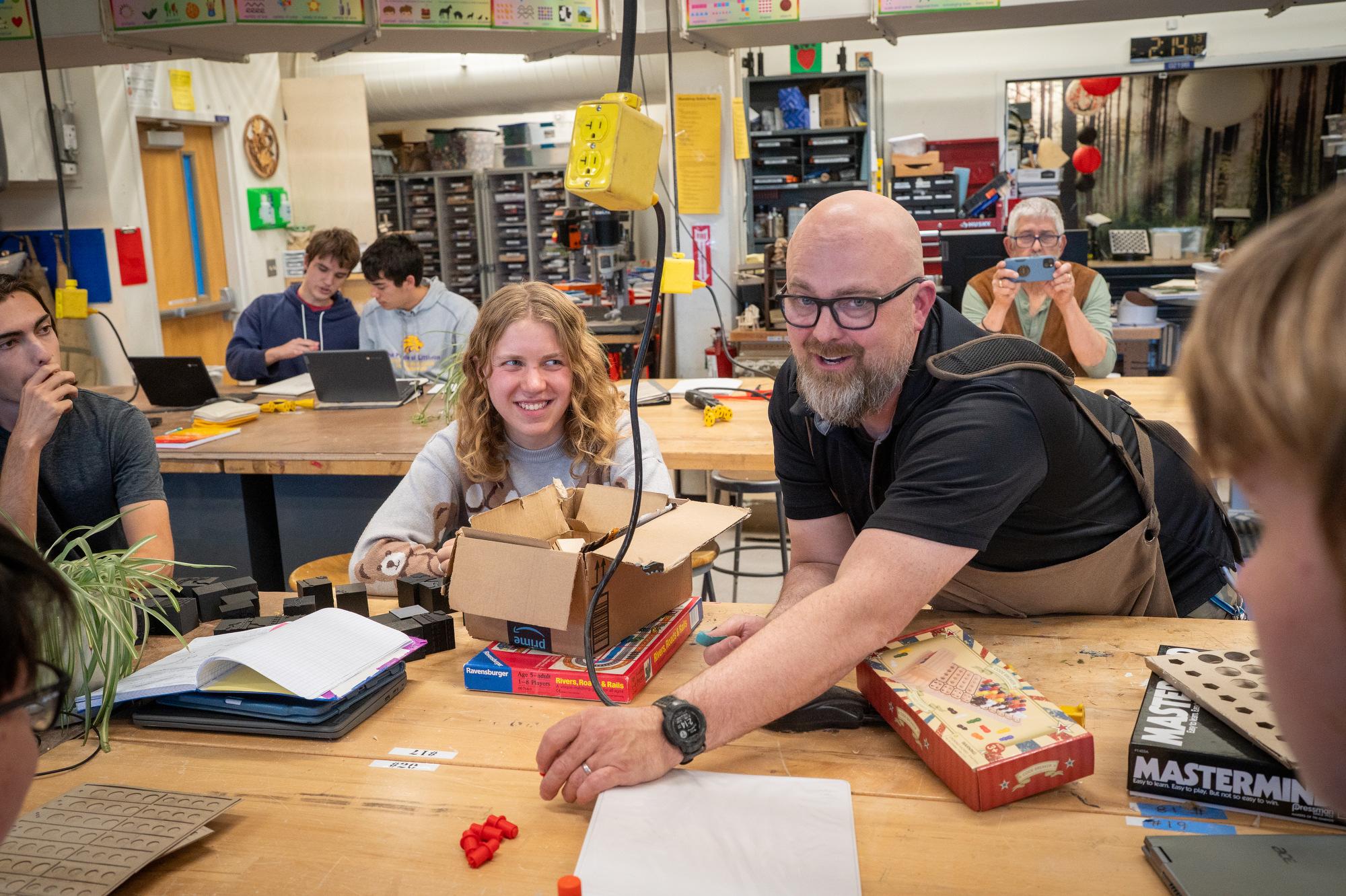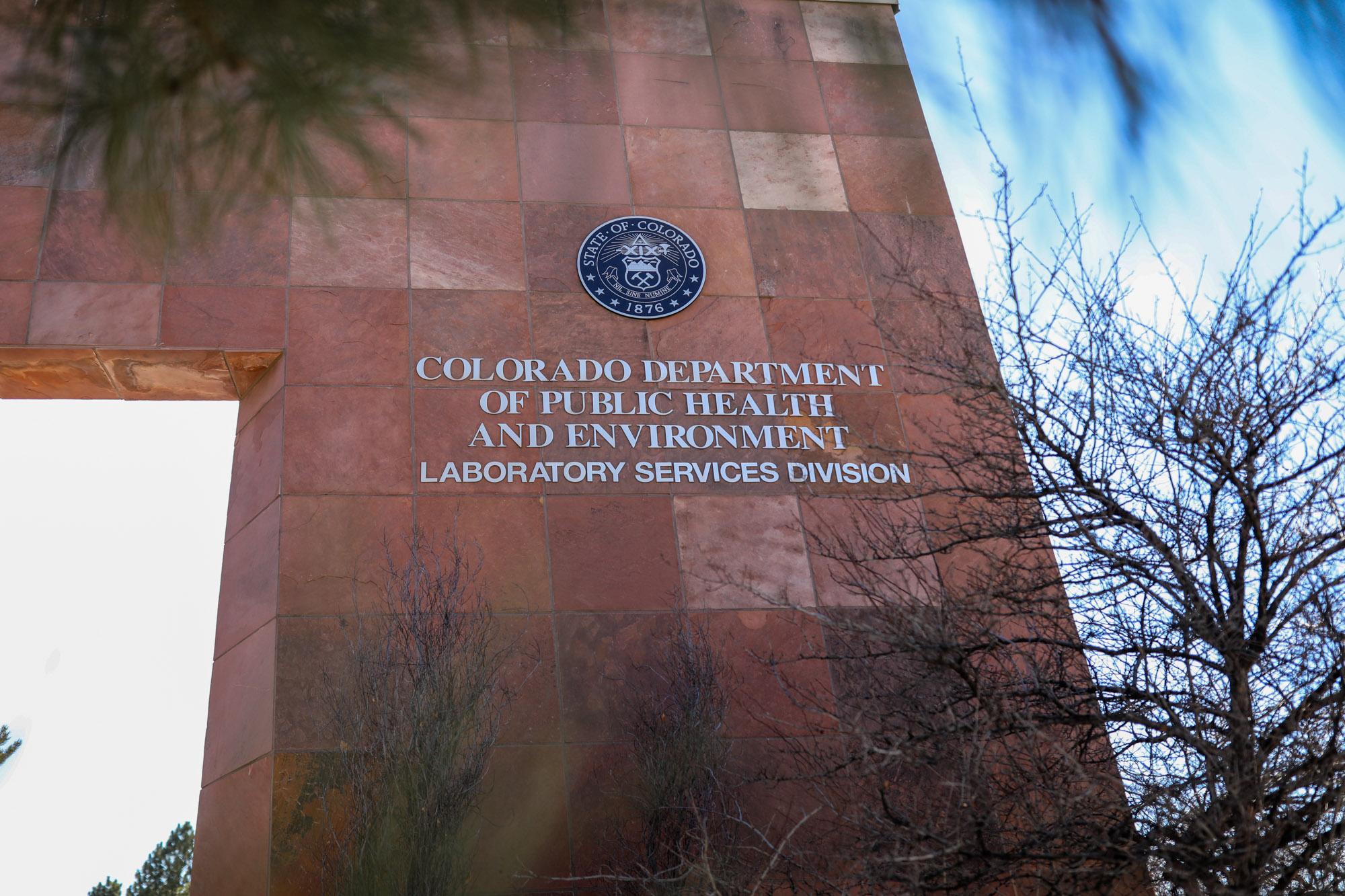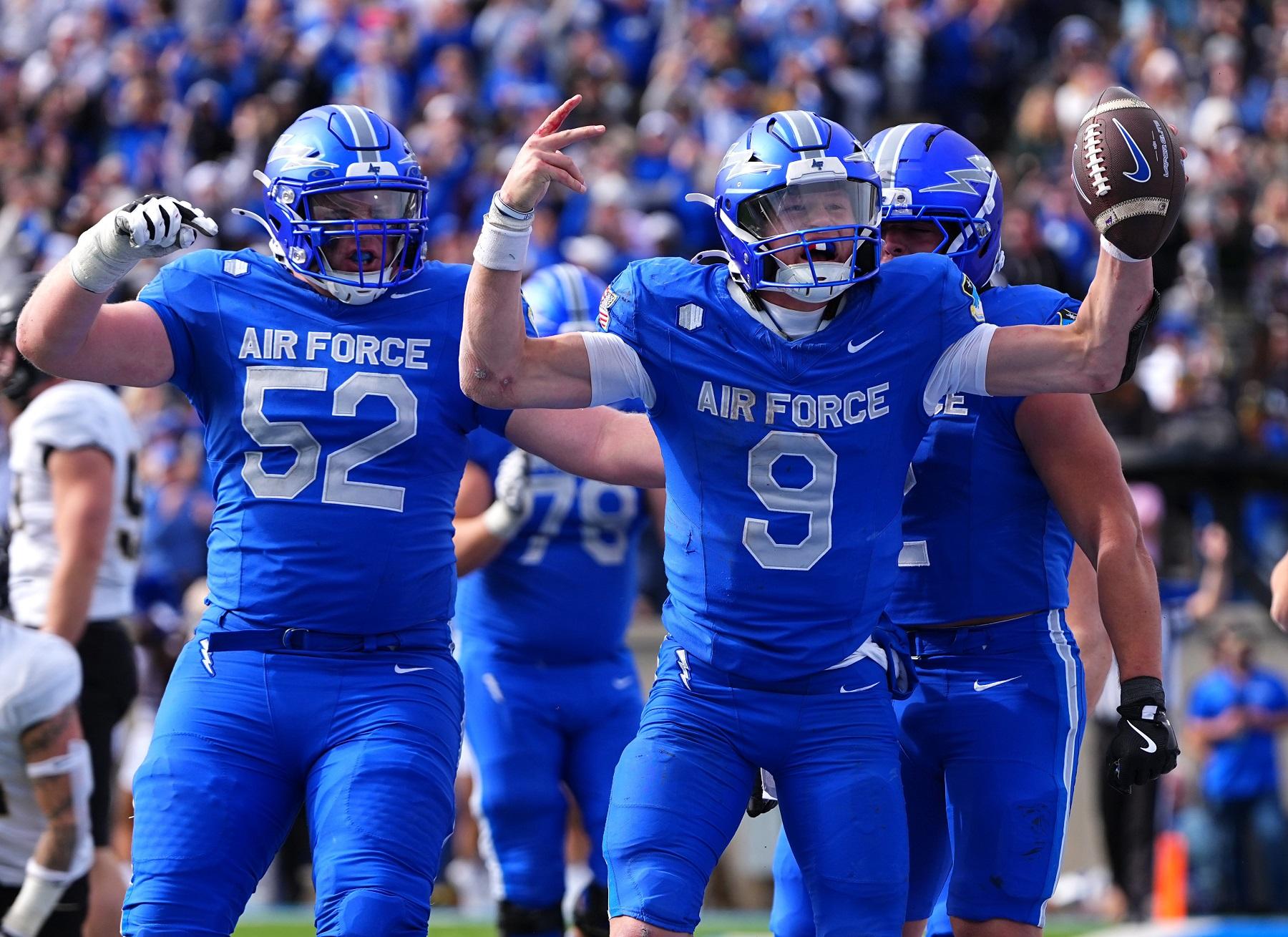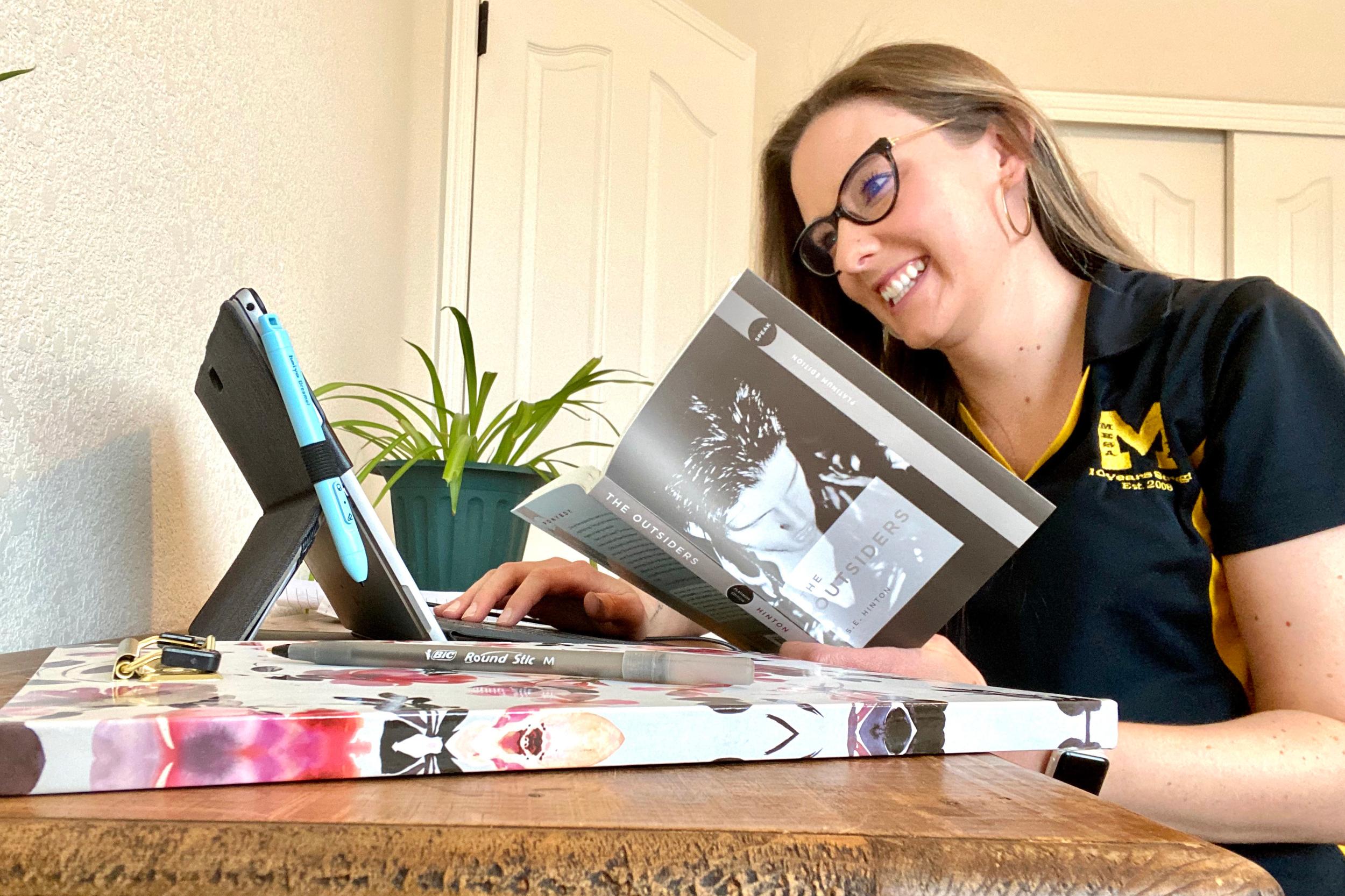
Jenna Butler’s first video of the day for her Legend High chemistry students is always a silly one, like of her taking out the trash or singing a song. This morning, she got up hours before her students to sing them her version of the classic “Sweet Caroline.”
“Good morning, everyone.” Butler says into the camera. “I am no Neil Diamond, and I don’t have a guitar to play. But don’t worry, I’m prepared.”
She holds a spoon and a metal bowl as she starts singing to the karaoke version of the song, with a few of her own substitutions.
“Sweet chemistry!” Butler belts out and hits her metal bowl three times — duh, duh, duh — a nice touch to get the most soporific of teenagers awake.
“Canvas has never seemed so good,” she sings, referring to the online learning platform she uses.
“So good!” she shouts.
Legend High, where she teaches, is a part of Douglas County, one of the first districts in the state to start remote learning after COVID-19 shuttered schools. Districts are increasingly finding that the quality of remote learning is dependent on a family's income level and a school's resources. Dougco, with its relative wealth and technological capabilities, was well-positioned to keep student learning going.
Still, the experience teachers like Butler have had with remote learning offers lessons for other districts across the state in how to succeed — and some of the pervasive challenges.
The coronavirus-caused school closures has illuminated deep digital inequities between districts.
Douglas County only had to distribute 1,700 devices for children lacking them at home.
Compare that to Denver, which has a higher number of students living in poverty or experiencing homelessness, and has struggled to connect everyone. There, schools had to distribute more than 40,000 Chromebooks.
In other districts, teachers are relying on paper packets and some students just aren’t engaging at all.
A new report shows two-thirds of Colorado children without internet access at home are Hispanic, and the majority of kids without internet access also have at least one parent who is an essential worker. These children live in all regions of the state, but the highest numbers are in southwest Colorado and in the metro Denver region, according to a new report from Colorado State University’s Colorado Futures Center.

Experts in online learning also note that effective online instruction usually involves planning, training in multimedia platforms ahead of time and in-person interaction on a regular basis. What Colorado teachers are doing is emergency remote learning, or making do in crisis situations, experts say.
Butler and other teachers and students at Legend High also have a big advantage because they were already familiar with Canvas, the online learning platform they’re now using. When Butler’s students log on, they go to a calendar and see lessons, quizzes, assignments and discussions — all online. The best part for chemistry is that Butler can conduct a lab experiment in her kitchen, on camera.
“Alright guys, welcome to my kitchen,” Butler says in one of these videos. “I may or may not have stolen some lab equipment from Legend High. Don’t worry, I’ll return it, I swear!”
The camera shows everything she’s doing as she narrates each step of a review lab: “A double replacement reaction of aqueous solutions of sodium carbonate and calcium chloride to find the percent yield of sodium chloride.”
That video is embedded in the lab instructions she’s following — and as she gets results, she writes them in the appropriate columns on camera so students can see. Not as good as a student doing his or her own lab, but it’s pretty impressive.
Since this is advanced chemistry, students have a lot of questions. So Butler makes more videos to answer their questions.
“One kid even emailed me and said that the short videos I'm making on the discussions have been a lifesaver,” she said.
Tech expertise makes a big difference in easing the transition to remote learning.
At Saddle Ranch Elementary school, other teachers didn’t start with as much technological know-how as Butler did.
“My learning curve has gone way up right now,” said sixth-grade writing teacher Colleen Meyer.
At the outset, Meyer found posting assignments online worked just fine. Kids often write in paper and pencil and would send Meyer a photo of their work, or post it in a Google doc.
But as the weeks wore on, Meyer ventured into the world of live chats with small groups. She says it’s helping her connect with students and answer questions.
Still, Meyer says teachers know they’re not being as effective as they could be in person. Other teachers say it's been hard to manage their time and stress right now.
The district has been clear that it doesn’t want students and teachers in front of computers seven hours a day. In fact, it has established Monday mornings as teacher planning days. But some teachers across the state say they and their principals struggle with setting those boundaries and sticking to them.
For example, Butler says it is more time-consuming to email students about chemistry or to make them videos (which involves filming, uploading, posting to YouTube and sending) than it would be to help them one on one during lunch or a plan period.
She’s observed that students are sleeping in now and working on classwork later in the day. That, along with Butler's own slower-moving social distancing life, has pushed her days later.
“I find myself responding to emails and questions at all hours," she said. "I could easily set boundaries and remove my email from my phone, but if I am sitting on the couch reading or watching TV and a student has a question, I feel that I may as well answer it for them."
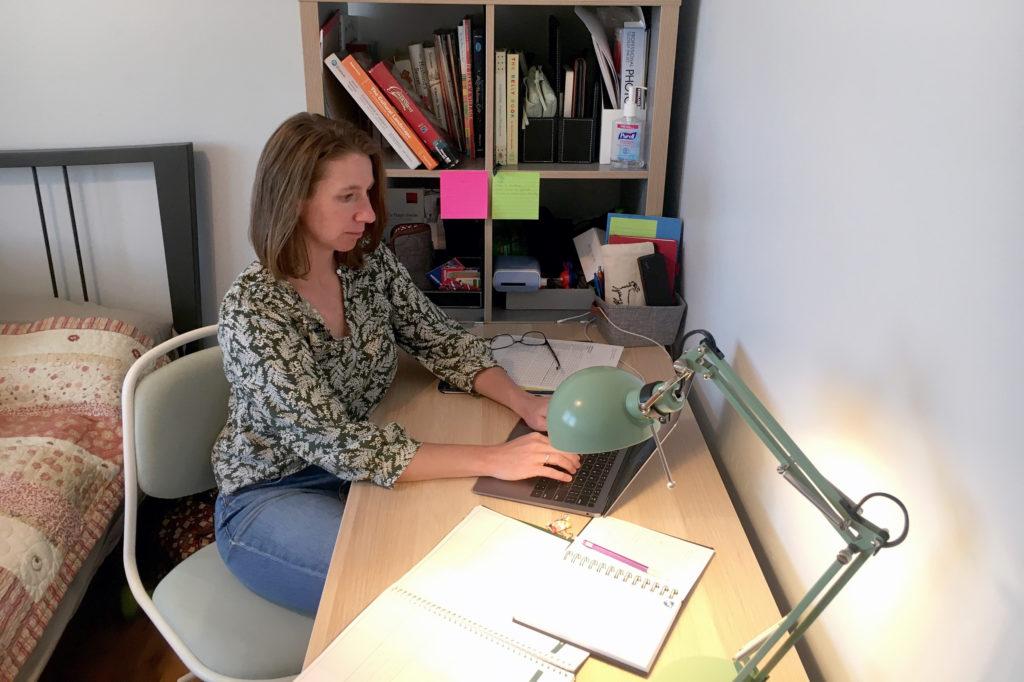
Emily Muellenberg is an English teacher at Highlands Ranch High School who sits on the Commissioner’s Teachers Cabinet, an advisory group to Education Commissioner Katy Anthes. She spoke with CPR News shortly after getting off a cabinet call and said most of the teachers, including her, reported working 11-hour days.
“It is just pedal to the metal all day,” Muellenberg said.
Teachers’ expectations for themselves are part of that. Many are hard-wired to perform at a high level, and Muellenberg said they’re compensating for not getting to be with kids in person.
“Even if we have a class that only has 40 percent of kids engaging with the online learning, for those 40 we want to make sure it’s worth their while, we want to make sure it’s engaging,” she said. “It is taking far more time and energy than a lot of us thought.”
Teachers have to rewrite lessons for a new medium. Teachers also collaborate a lot, and that’s harder to do at a distance.
And, Muellenberg jokes, there’s no bells telling them when to stop.
“Some of us just don’t stop. It’s not healthy, I know it’s not.”
“We just have to figure out the ways to reach them in this different setting.”
Some teachers are also trying to restore some routines, modified for the current circumstances. At Mesa Middle School in Douglas County, each morning there’s an announcement from the principal or a teacher or a student posted on the school’s website.
Each grade — divided into teams like Panda, Sun, and Grizzly — has their own daily announcements and assignments posted, with links to wellness and remote student counseling support.
The school is also trying to restore some of the social connection kids get in school. Kids can do flip grid videos, show and tell or Mindcraft with math, as well as other activities that encourage them to interact.
English teacher Niki Brock hosts live optional video chats, like a book club, in three different time slots so more students can make it. She also records it so kids can listen later.
Brock spends a lot of time thinking about how to connect with the students who are harder to connect with.
“But as educators, we're built for that, right?” she said. “So we just have to figure out the ways to reach them in this different setting.”
She gets insights into how her students are doing emotionally by having them write in a weekly journal. They reflect on what they’re learning during stay-at-home orders.
“I almost get emotional talking about it — but watching what they've learned and how well they're responding to this and just how supportive like the community has been ...” her voice trails off.
One of Niki Brock’s students wrote to her to say:
“This time started off as boring and not exciting, I wasn’t ready to do any of the work I had been assigned. But once I started I didn't want to stop, I felt excited to start work in the mornings and I didn’t get bored every time I had to sit behind my computer and do my work.”
Brock says especially now, getting kids’ input on how class is going and how to teach is essential.
“Showing kids that you are using their feedback, their voice in designing this, [like] ‘My teachers are listening to me, just because we're online now, it doesn't mean that they've stopped listening to me,'” she said.
On Fridays, Brock’s team hosts a virtual team-building call, with five teachers and upwards of 100 kids. Each teacher recognizes two students with a “virtual badge” for going above and beyond, people take turns sharing positive experiences and new hobbies from the week. They play a team-building activity called a kahoot, and end with an open Q&A session. The kids are on mute when they’re not talking, but they can chat questions. Brock has been amazed it actually works. That’s helping her keep a positive attitude.
“I think this is going to be such a learning process for teachers, for students, for parents. And while it is challenging, I really think we're going to come out of this whole situation having so many other tech tools and life lessons that have been learned," Brock said. "You have to look at those positive things that can come out of this time as well."
Districts have to address the uncertainty of the current situation.
Douglas County is hosting virtual town halls to answer the public’s questions. People wanted to know whether teachers will know how much learning students miss out on during the school shutdowns.
In a town hall on April 16, superintendent Thomas Tucker said the district will take baseline data to see where students are now academically. Students will be assessed again in the fall. But in the meantime, Tucker said, “we have a moral and educational obligation to ensure that each of our 68,000 students do experience some academic growth over the remainder of this year.”
It’s not just a matter of kids “hopping online for an hour or so,” he said. Educators and parents can use this time to teach kids life skills “like how to balance a checkbook, how to sew, how to cook, and not focus so much on testing,” or let students go deeper on a subject that regular school doesn’t allow, Tucker said.
Like other school districts across Colorado, Douglas County officials are waiting for guidance from state and health officials before finalizing plans about whether schools will open in the fall.
“We are looking at the possibility of continuing remote learning in the fall,” Tucker said. “We hope not, but at the same time we have to be prepared if that does happen.”
Dr. Adam Barkin, an emergency medicine physician who spoke during the virtual town hall, is hopeful students will be able to go back to school in the fall with changes.
“There may not be the same large scale gatherings at schools that there have been in the past,” Barkin said.
But, he expects schools will be able to resume some semblance of normalcy.
Editor's note: Due to an editing error, an earlier version of this story incorrectly attributed quotes by Emily Muellenberg.

